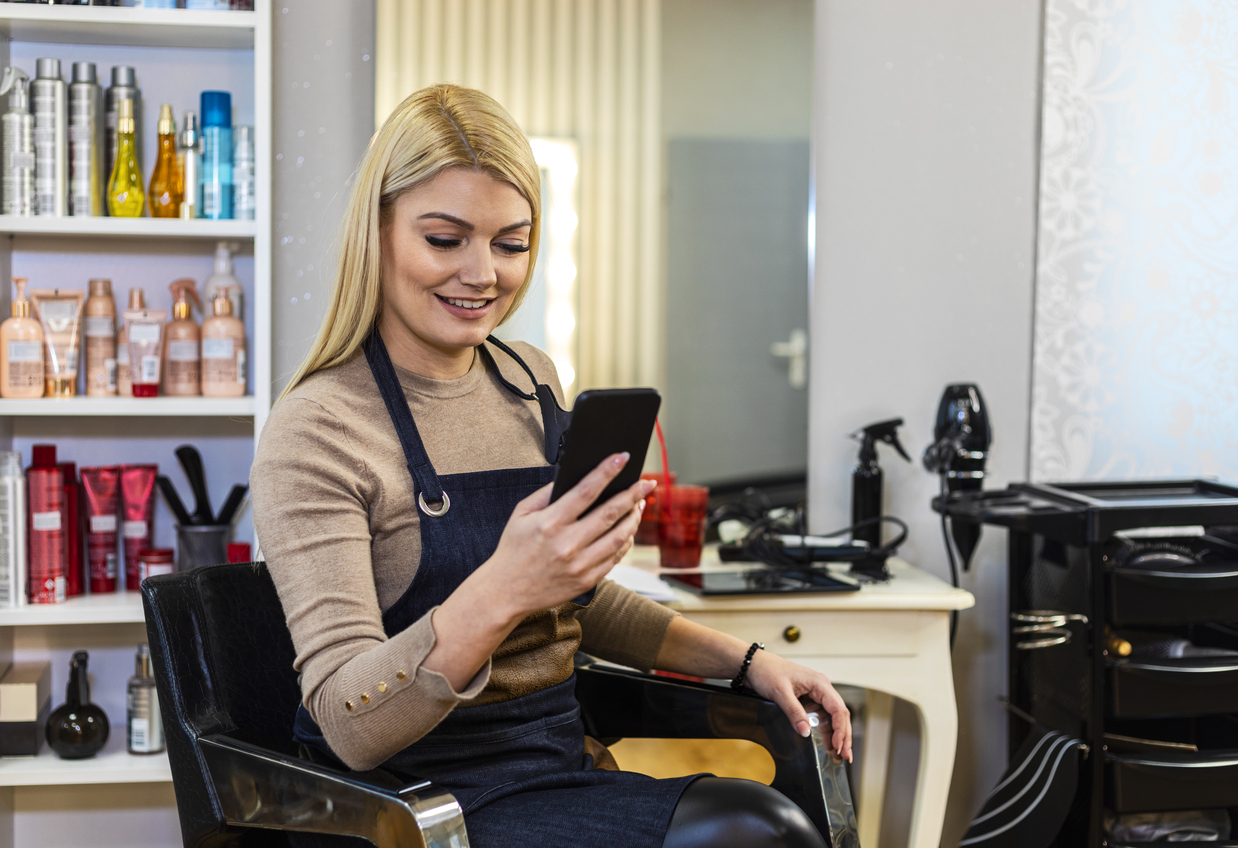Queue Up To Be Pampered – A Salon Manager’s Guide To Queue Management

6 Feb 2023
Salons aren’t just about getting glammed up. It’s a place where customers go to relax, be pampered, and forget about their daily stresses.
The problem? Having to queue up for your treatment is one of the least luxurious sensations in the world.
Your customers associate waiting in line with grocery stores, going to the DMV, and basically every other stressful mundane task in their lives that led them straight to you in the first place. The less time they spend waiting and watching other people get their hair/nails/everything done, the better off they’ll feel at the end of it.
So what’s a salon manager to do?
Thankfully, there are better ways to manage your queues that are good for any salon and your clients’ glow-ups. Read on to find out more about how to queue up in style.
What It Means to Queue Up: Types of Queueing
Lining up isn’t always as simple as people standing one after another.
Queue up meaning a straightforward line isn’t something business owners should take for granted. There are more terms defining the way customers can wait that a salon manager should understand while thinking through how to optimize queues.
Customer Queueing
When you think of lining up, this is what probably comes to mind: a group of people, standing in a line one after another, waiting to be served. Customer queueing (or physical queueing) refers to exactly that.
Physical queues are everywhere. Common examples can be seen in settings like:
- Grocery stores
- Coffee shops
- Amusement parks
- Movie premieres
- Salons (of course)
No matter whether people are standing or sitting, there’s one thing all customer queueing has in common: it’s time-consuming. Customers have to stay put in a physical location before their turn arrives, however long that will take.
For the business, in-person queueing may seem to need the least amount of planning, since it can occur spontaneously. But you need to think about it from a broader perspective.
To accommodate people waiting in your salon, you’ll need to set up chairs, hire someone for front desk customer service, distract or entertain them with magazines, newspapers, maybe even screens. If you’re looking at long lines, you might even need additional bathrooms for the people who have been waiting for a while.
Even the most comfortable, well-planned physical queue still means your customer is waiting. When in a liminal space, they’re not going to be perfectly comfortable or at ease. On average, people are not willing to wait in line for longer than 14 minutes during in-person waits.
Thinking about how to improve your queue management means putting some thought into eliminating physical queues.
Ticketed Queueing System

Thanks to modern technology, physical queueing is no longer the only option. A ticketed queueing system issues numbered tickets to customers when they arrive at the business to queue up, usually via a kiosk on-site.
Ticketed lines offer a few advantages over old-fashioned waiting in line, such as:
- Organization. No more concerns over people cutting forward while queueing. Numbered tickets clearly indicate when customers arrived and when they should be served.
- Increased freedom. Customers can come and go freely if their number is far from being called and no longer have to stand in line physically with a ticketing system.
- More predictable. With the order pre-designated, waiting is a little less unpredictable.
- Accessibility. Forcing people to stand in line for prolonged periods of time limits accessibility for those with disabilities or other issues. Giving them the liberty to move around makes the waiting more accessible.
Although it improves upon customer queueing, ticketed queueing still has its own flaws. There’s increased freedom, predictability, organization, and accessibility, but people still have to queue up in a specified zone. They’re not truly free to do whatever they want.
Plus, the business still needs to maintain the physical space for waiting customers. For a salon, this might mean cutting down on a few chairs since some people prefer to not wait on-site the whole time. At the end of the day, they’ll still have to come back close to their appointment and wait for an unspecified amount of time before actually getting served.
That’s not the only business cost. Buying and setting up kiosks is a big job, especially for smaller salons. Printing out paper tickets is another expenditure, in addition to not being environmentally friendly.
Queue Management Software

Ticketed queueing systems make use of software as well. So what sets queue management software apart?
Queue management systems let your customers queue up online. What’s more, they don’t even need to show up to your physical location until their turn is close.
No longer will you have to worry about managing your queues. Your software will record each appointment or queued person in real-time as they book. In the meantime, you just need to pay attention to customers when they finally walk into your salon.
Data-driven queue systems can even help you analyze a variety of factors, from waiting time to employee performance. They’re accessible to your customers via apps, website portals, and on their phones, laptops, tablets, or whatever other devices they may prefer.
Here’s a quick breakdown of how a queue management software compares to ticketed and customer queueing in a few key categories:
| Organization | Freedom | Accessibility | |
| Customer Queueing | Challenging | No freedom | Low |
| Ticketed Queueing System | Organized, not centralized | Somewhat free | Low |
| Queue Management Software | Highly organized, highly centralized | Completely free | High |
In every category, management software outclasses the more traditional forms of queueing. But there’s even more to be said about why traditional customer queueing needs to be revamped for the modern age.
3 Common Problems with Traditional Queues
Waiting in a queue is inherently boring. Your clients don’t want to stand in line if they can avoid it. Here are three common problems with traditional queueing that may end up turning customers away from your business.
- Disorganized
- Lack of Accessibility
- Not Scalable
Problem 1: Disorganized

Just because you have rules set up for lining up doesn’t mean your customers will follow them. Putting people together in a small physical space like a salon and telling them to stay in order tends to result in a lack of organization.
You may encounter:
- Line-jumpers
- Saving spots
- Missing their turn
- Being loud/rude to other customers
84% of customers say they value their experience at a business just as much as the services they receive. What does this mean for your business?
Even if a specific client in line acts up, your average customer will associate that negative experience with your business and be less willing to return. No matter how good their haircut or spa treatment or whatever service they receive ends up being, they will value the environment where they wait just as much and avoid coming back.
Having too many customers wait in your space just increases the potential for customer friction. You don’t want to ramp up that possibility by inviting more people into your space to line up.
Problem 2: Lack of Accessibility
Not everyone has the time or physical ability to wait. Your customers probably come from diverse circumstances. Failing to provide for as many people as possible will reduce the number of people you can serve.
Accessibility matters, both physically and in terms of time:
- Physical accessibility. People with disabilities or other issues won’t be able to queue up in a limited salon space for extended periods of time. You need to take into account your customers’ diverse physical needs.
- Accessibility via availability. Entrepreneurs, new parents, busy business owners–many of your customers are probably busy, day in and day out. If your salon requires a long wait on-site, they’ll end up going somewhere else for their needs.
At the end of the day, that principle applies to most aspects of a business. You need to account for what your customers can afford to give you in terms of time, money, physical energy. The best businesses accommodate their customers, not the other way around.
Problem 3: Not Scalable
Every business wants to grow, and a salon is no different. Whether it’s expanding one shop or opening multiple locations in a chain, growth looks different for everyone.
One of the most essential aspects of scaling? Making sure customers can be served just as easily as before. Rising business costs can make this difficult, especially for companies without a good queueing solution.
Here’s a quick table you can reference to study how difficult it is to scale traditional queueing solutions.
| Scaling Customer Queueing | |
| Space | Needs to expand to accommodate more customers. |
| Customer Service | More people are hired to handle customers, including scheduling appointments and dealing with them on-site. |
| Time Consumption | With more employees = more business time overall spent on customers. |
| Cost per Customer | Cost of wrangling customers increases due to more time and space dedicated to them. |
Traditional queueing works in the short term, but as a business scales, it will inevitably have a harder time managing customers across locations and employees.
How to Choose a Queue Management System for Beauty Salons
Picking the right queue management system largely depends on your salon’s needs. Do you need:
- Cross-platform/browser integration?
- 24/7 availability?
- Web portal or app?
- Custom alerts/notifications?
- Real-time waitlist updates?
- Post-appointment surveys?
- Analytics?
The key to choosing a good option is ranking what you value most in a queue management system. How much can your employees do? What do you want a queue management tool to take over for you? What are you struggling most with right now in terms of queueing? How much can you afford to spend on a solution? Do customers want access to virtual location booking for their appointments?
Thinking hard about all these questions and more will help you pick the right option.
Benefits of A Queue Management System

A queue management system can bring comfort and convenience to both your salon and your customers. Here are some benefits to integrating one.
Benefit 1: Improved Customer Service
What do your customer reps spend most of their day on now?
Chances are they spend far too much time on the phone, scheduling appointments for clients, clearing up confusion over dates, and other petty scheduling-related tasks.
Integrating a queue management system will help them clear their own calendar. When your front desk employees no longer have to spend hours on customer management, they can turn their attention to real customer service.
Spending hours on queue management is good for nobody, and won’t even do much to improve your customers’ impression of the business.
Greeting customers with a smile and high spirits? That’s how you earn a positive review.
Benefit 2: Accessibility
Good queue management tools like Skiplino have customizable notifications and alerts. You can set up reminders for your clients the morning of their appointment, two hours before their appointment, or just whenever you want.
They can queue up in your virtual queue from their phone and swing by when it’s their turn. If they don’t show up, you simply bump up the next person in line.
No matter how busy your customers are or how little physical tolerance they have for waiting, an online queueing solution brings them right to their door when you’re ready for them, no earlier or later. That’s the kind of accessibility you owe your customers.
Benefit 3: Analytics

You can’t improve without knowing what you’re doing wrong. Quality queue management tools help you with this by providing you with detailed, easy-to-read analytics. You’ll be able to track analytics like:
- Customer wait time
- Booking device/browser information
- Employee service time
- Satisfaction rate
No more stabs in the dark when it comes to allocating your monthly budget. Having analytics on hand will give you an idea of what you really need to focus on to improve your customer service, in-store experience, and online queueing.
How Cloud-Based Queue Management Systems Work
Cloud-based queue management systems are intelligent and responsive. They don’t just queue up customers and deliver them into your hands. What they do is:
- Collect queue data and customer feedback in real-time
- Report to you and your sales/customer service team
- Deliver streamlined recommendations to improve customer satisfaction
In a way, cloud-based systems aren’t so different from a hyper-powered customer service rep. They schedule your clients’ appointments, queue them up in order, collect their information and feedback, and deliver everything to you at the end of the day. They don’t need to rest and will never make mistakes. All of these aspects and more make for a fantastic solution for service-based industries like retail and salons.
Implementation
When all is said and done, actually setting up a queue management system may seem like the most intimidating step of all. Follow these steps and you’ll be set:
- Set up a queueing flow. Study how your current queueing process flows and decide how you want to improve it. Do you want customers to check-in in-person? Register online? Which customer touchpoints improve their experience, and which are redundant?
- Plan for hardware. Although cloud-based queue management can work straight from your customer’s phone, some salons find it helpful to set up a kiosk or tablet for customers to register or double-check their queue information. Know your budget and plan accordingly.
- Consult your staff. Make sure the front desk employees who will be working with this technology the most are comfortable with it. Do they have feedback on the queueing flow? How will they end up using it? Will they require training?
- Try it out internally. Before you bring the new system public, try it out internally to see if there are any hiccups in the queueing process. You don’t want to hear about simple flaws from your customers if you can catch them on your own.
- Keep monitoring. Don’t let your guard down when everything is set up. Customers and employees alike will have more feedback for you as they use the system on a consistent basis. Keep tweaking each touchpoint and improving performance.
Implementing a new way of queueing can seem challenging, but it doesn’t have to be. Follow what’s best for your customers and you can’t go wrong.
Queue Management System Success Stories for Beauty Salons

Curious to see how smart queue management has improved the business of real beauty salons? Read on for success stories on how salons have used this technology to glam up their business.
Pigtails and Crewcuts
This hair salon in Charlotte, North Carolina for children and families started with a clipboard and sign-in sheet before transitioning to scheduling software. Since then, they’ve experienced these benefits:
- Sales reps have more time for face-to-face customer service
- Reduced time spent on queue management (e.g. passing clipboard back and forth, tracking down clients)
- Identified clients based on age, matching them to correctly-sized chairs
- Mobile-compatible check-in process
- 171 haircuts in a single day, exceeding the national record for the chain
Good queue management is how salons can improve efficiency and quality and find success where they couldn’t beforehand.
Glow Tanning Nails and Beauty
Glow Tanning provides a wide range of beauty treatments. But for the longest time the salon operated everything from one massive diary, littering their days with errors and mismanaged client data.
Finally, they made the switch to a booking software. They saw results like:
- Beauticians planning better for busy and relaxed days due to open calendars
- 40% of bookings arrived through the website
- Less time spent on scheduling, more time spent with customers
- 5-star reviews from customers on the software switch
- An easy way for clients to book their favorite beauticians
- Opened a sister location in 2019
Beauty Studio
Superdrug, a large-scale UK health and beauty retailer, was launching Beauty Studio, an on-site brow and nail bar and salon. They implemented a queue management solution and experienced the following benefits:
- 24% increase in beauty service sales
- Reduced no-shows, increased return appointments
- Allowed them to analyze resource allocation and distribute employees more effectively
- Increased impulse purchases in-store
- Improved customer loyalty
With the right queue management software, salons big and small can see positive returns on their business.
Frequently Asked Questions
Q: What does it mean to queue up?
A: Queueing up can refer to customer queueing, ticketed queueing, and queue management systems. The latter two make use of kiosks/software to distribute orders to customers, although only the queue management system frees customers up until it’s their turn.
Q: Why should salons use queue management software instead of traditional queueing?
A: Traditional queues are slow, inefficient, and inaccessible. Queue management software solves all of these issues and lets customers pick their own time, saving the business time when it comes to scheduling.
Q: Is it difficult to scale with queue management solutions?
A: No. You simply need to buy more devices or upgrade your software plan to scale up.
Q: What is a good scheduling software for salon managers to implement?
A: Skiplino is a great solution that offers smart reporting, queue management, appointment booking, and more. You can check out a 7-day free trial here.
Latest



Similar Reads


All Rights Reserved @2025 Skiplino Technologies WLL.




